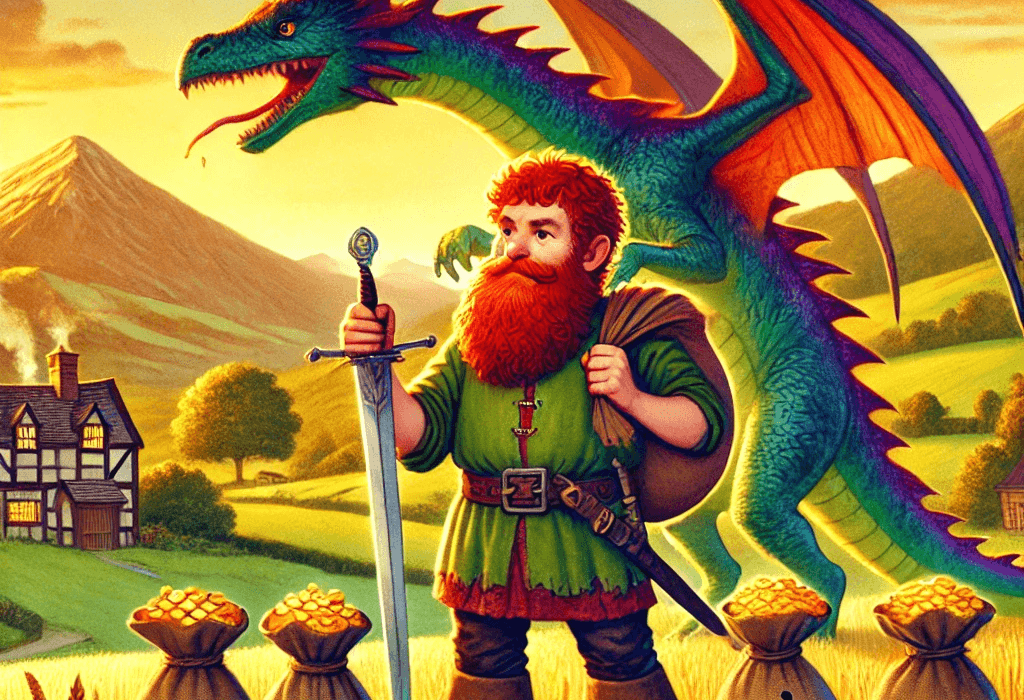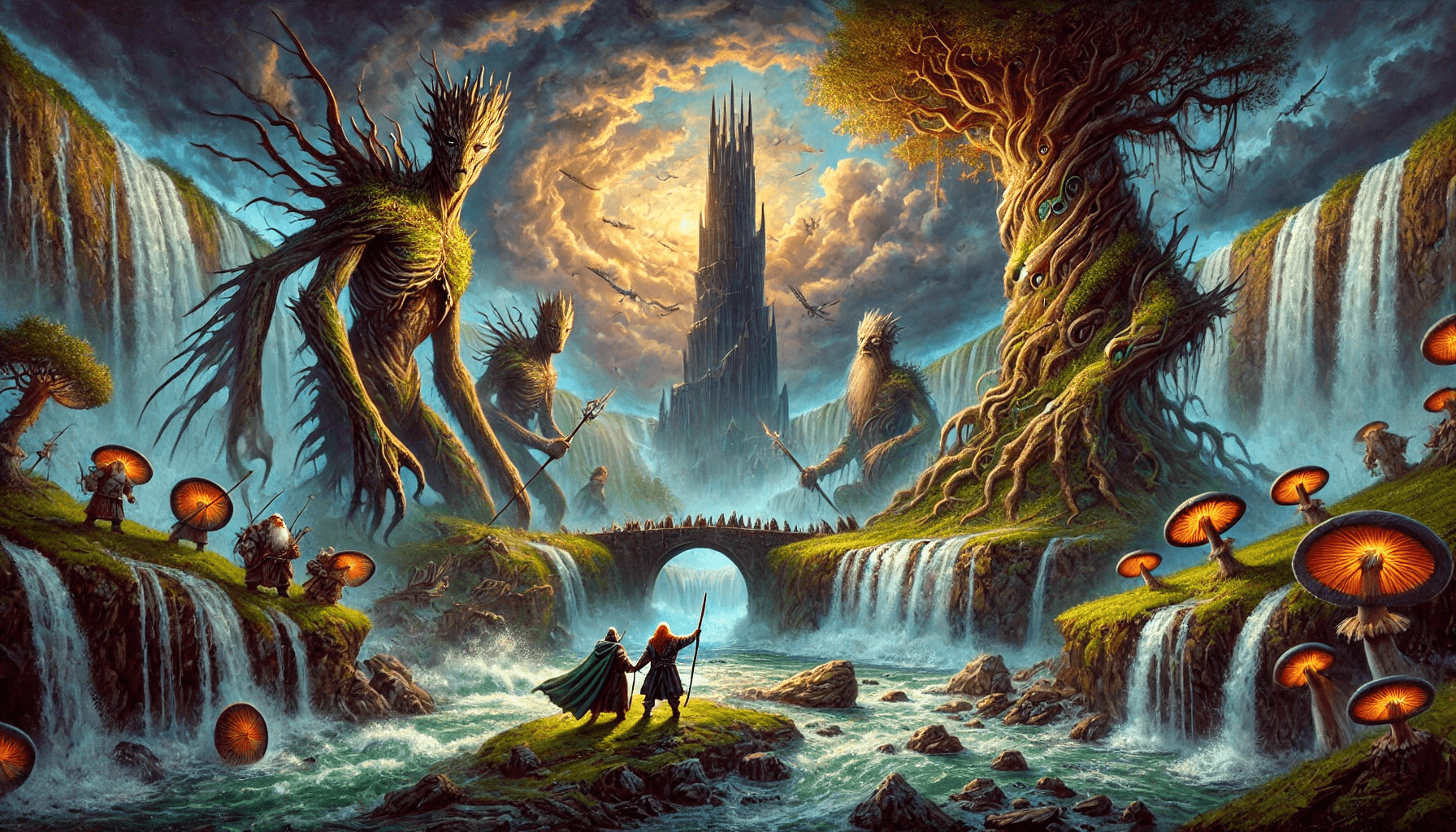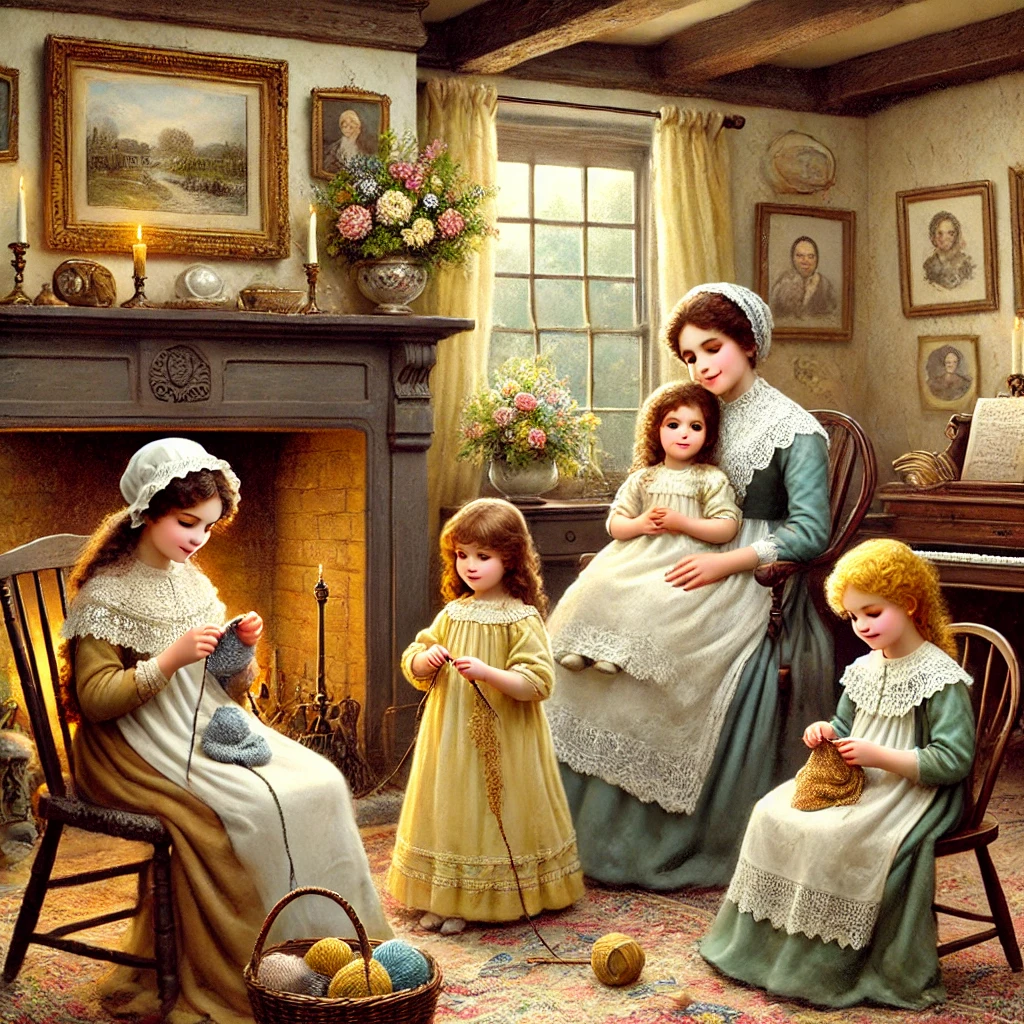“Farmer Giles of Ham” is a lighthearted novella written by J.R.R. Tolkien, first published in 1949. Set in a whimsical and pseudo-historical version of Britain, the story follows the unlikely rise of a farmer, Aegidius Ahenobarbus Julius Agricola de Hammo (Farmer Giles), who becomes a hero after confronting a giant and later a dragon. Filled with humor, folklore elements, and satirical commentary, Tolkien combines his linguistic expertise and storytelling charm to create a delightful medieval fable.
Plot Summary
Farmer Giles of Ham was a man of unassuming stature who lived in the peaceful village of Ham, nestled in a tranquil part of the Little Kingdom. A slow and steady farmer, he cared little for the affairs of the world beyond his fields and market trips. His dog, Garm, shared a similar disposition, though prone to chatter and boasting when the occasion arose. For years, the lives of Farmer Giles and his neighbors had been undisturbed, until one fateful evening when the rumble of heavy steps announced the arrival of a wandering giant.
The giant, blind to the devastation his enormous feet caused, trampled Giles’s fields, crushed hedges, and even squashed the farmer’s prized cow. Garm, terrified but eager to inform, roused his master from slumber. Grumbling and armed with his old blunderbuss—a weapon rarely fired—Giles ventured out. Fortune favored him; as the giant’s head loomed over the hill, the blunderbuss discharged its makeshift ammunition, hitting the giant in the face. Startled and mistaking the assault for an attack from stinging insects, the giant retreated into the night.
The village celebrated Giles as a hero. He accepted the newfound attention with quiet satisfaction, enjoying the free ale and praise that followed. Even the King, upon hearing of Giles’s feat, sent a royal letter of commendation along with an ancient sword, Tailbiter. While Giles admired the gift, he dismissed it as a relic and continued his routine, content to let the world believe him braver than he felt. Yet, peace did not linger long.
Word of the fertile lands and unguarded livestock in Ham reached the ears of a dragon named Chrysophylax Dives, a creature renowned for his greed and vast hoard of treasure. Chrysophylax, driven by hunger and cunning, descended upon the countryside. The destruction he wrought was swift and terrible; barns burned, cattle vanished, and villages trembled. News of the dragon’s approach reached Ham, and the villagers, emboldened by Giles’s past triumph, insisted he confront the beast. Unwilling and burdened by his reputation, Giles found himself roped into the venture.
With no formal armor to protect him, the villagers improvised, stitching rings onto his old leather jerkin and fitting him with a makeshift helmet. Tailbiter, gleaming and ready, refused to stay in its sheath—a sign, the parson assured, of its magic and purpose. Mounted on his old grey mare and accompanied by the reluctant Garm, Giles set off in search of Chrysophylax.
The journey was nerve-wracking, filled with the eerie silence of lands ravaged by the dragon. Yet, despite his fears, Giles stumbled upon Chrysophylax unexpectedly. The dragon, lounging across a road, eyed the farmer with curiosity and amusement. Giles, fumbling to retrieve Tailbiter, unwittingly activated its magical properties. The sword leapt into action, startling Chrysophylax with its sharpness and swift movements. Recognizing the threat, the dragon retreated, injured and astonished.
Determined to avoid further harm, Chrysophylax sought to bargain. Pleading for mercy, he offered Giles and the villagers a share of his treasure if they let him return to his mountain lair to fetch it. The villagers, emboldened by Giles’s apparent victory, eagerly agreed to the terms, despite the blacksmith’s doubts about trusting a dragon’s word. Chrysophylax swore elaborate oaths to return within days, laden with wealth, and departed.
Days turned into weeks, and no dragon appeared. The villagers’ excitement soured into frustration. Meanwhile, the King, hearing of the promised treasure, arrived in Ham with his retinue, intent on claiming the hoard for himself. His demands left little for the villagers or Giles, who found himself swept up in royal schemes. The King commanded Giles to lead an expedition to confront Chrysophylax and retrieve the treasure by force.
Reluctantly, Giles accompanied the royal knights on their journey to the dragon’s lair. Unlike Giles, the knights were more interested in appearances and pomp than facing true danger. When they neared the dragon’s mountainous domain, their boasts faltered, and their courage waned. Chrysophylax, now defending his home, unleashed his fury upon the ill-prepared knights, scattering them with fire and fear. Amid the chaos, only Giles and his steadfast mare remained.
Tailbiter, sensing its purpose, guided Giles in the confrontation. Giles, more determined to survive than to triumph, found himself wielding the sword with surprising skill. Chrysophylax, recognizing the farmer’s resolve and the sword’s power, surrendered. He lamented his misfortune and pleaded once more, promising not only gold but also peace if Giles spared his life.
Seizing the moment, Giles demanded that the dragon personally deliver his hoard to Ham as reparations. The villagers, awestruck by the returning procession of treasure-laden wagons led by Chrysophylax, hailed Giles as a true hero. The King, furious at being outmaneuvered, attempted to claim the treasure, but Giles, now backed by the loyalty of the villagers and the dragon’s begrudging obedience, resisted royal interference. Chrysophylax, though reluctant, found himself bound by the farmer’s shrewdness and Tailbiter’s presence.
In time, Ham prospered beyond imagination. Giles, now rich and respected, grew content in his role as a local lord, keeping Tailbiter hung prominently on his wall. Chrysophylax slunk back to his mountain, wary of meddling with farmers ever again. The King, thwarted and humiliated, retreated to his court, leaving Ham and its unlikely champion to enjoy the fruits of their victory.
Thus ended the tale of Farmer Giles, a man who, through wit, courage, and a bit of luck, rose from humble beginnings to achieve renown, proving that heroism can come from the most unexpected places.
Main Characters
- Farmer Giles (Aegidius Ahenobarbus Julius Agricola de Hammo): A humble, resourceful farmer with a red beard who unexpectedly becomes a hero. Initially portrayed as reluctant and ordinary, his bravery and cunning shine through, especially in his dealings with the dragon Chrysophylax.
- Chrysophylax Dives: A rich, cunning, and cowardly dragon with a penchant for hoarding gold. He serves as both a comedic and threatening antagonist.
- Garm: Farmer Giles’s dog, who provides comic relief with his chatter and cowardly nature. Despite his flaws, he plays a crucial role in alerting Giles to danger.
- The Giant: A bumbling and destructive figure who inadvertently propels Giles into fame by wandering into his fields.
- The King: A self-serving monarch who seeks to claim Chrysophylax’s hoard for his treasury. He represents Tolkien’s subtle critique of authority.
- The Villagers of Ham: A mix of supportive and skeptical townsfolk who admire Giles but also push him into challenging situations, such as confronting the dragon.
Theme
Heroism and the Common Man: Farmer Giles represents the reluctant, unlikely hero trope. His rise to prominence is not through traditional valor but through wit and pragmatism. This subverts the grandiose hero archetypes common in medieval tales.
Satire on Power and Authority: Tolkien humorously critiques figures of power, including the King and knights, portraying them as greedy, ineffective, or pompous compared to the resourceful farmer.
Greed and Wealth: The dragon’s hoard and the villagers’ fixation on treasure highlight human (and dragon) greed. The story explores how wealth can both corrupt and unite communities.
Folklore and Mythology: Drawing on medieval legends, the tale incorporates dragons, magical swords (such as Tailbiter), and heroic deeds while maintaining a tongue-in-cheek tone.
Language and Naming: Tolkien’s love of philology shines through with playful and elaborate names (e.g., “Aegidius Ahenobarbus Julius Agricola de Hammo”) and the contrast between Latinized and common vernacular terms, adding depth and humor to the story.
Writing Style and Tone
Tolkien employs a whimsical and satirical tone throughout the novella. His writing blends formal, archaic diction with colloquial humor, evoking both medieval chronicles and folk tales. The narrator adopts an omniscient perspective, often interjecting with humorous asides and commentary, which enhances the charm and accessibility of the story.
The narrative is rich in descriptive language, especially when portraying Chrysophylax and the rustic countryside. Tolkien’s skillful use of irony and parody pokes fun at both medieval traditions and modern societal structures. Yet, the tale remains endearing and sincere, celebrating the ingenuity and courage of the ordinary man.
We hope this summary has sparked your interest and would appreciate you following Celsius 233 on social media:
There’s a treasure trove of other fascinating book summaries waiting for you. Check out our collection of stories that inspire, thrill, and provoke thought, just like this one by checking out the Book Shelf or the Library
Remember, while our summaries capture the essence, they can never replace the full experience of reading the book. If this summary intrigued you, consider diving into the complete story – buy the book and immerse yourself in the author’s original work.
If you want to request a book summary, click here.
When Saurabh is not working/watching football/reading books/traveling, you can reach him via Twitter/X, LinkedIn, or Threads
Restart reading!








